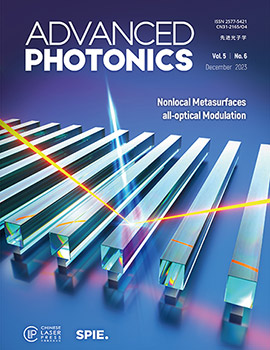Optical information transfer through random unknown diffusers using electronic encoding and diffractive decoding
IF 18.8
1区 物理与天体物理
Q1 OPTICS
引用次数: 0
Abstract
Abstract. Free-space optical information transfer through diffusive media is critical in many applications, such as biomedical devices and optical communication, but remains challenging due to random, unknown perturbations in the optical path. We demonstrate an optical diffractive decoder with electronic encoding to accurately transfer the optical information of interest, corresponding to, e.g., any arbitrary input object or message, through unknown random phase diffusers along the optical path. This hybrid electronic-optical model, trained using supervised learning, comprises a convolutional neural network-based electronic encoder and successive passive diffractive layers that are jointly optimized. After their joint training using deep learning, our hybrid model can transfer optical information through unknown phase diffusers, demonstrating generalization to new random diffusers never seen before. The resulting electronic-encoder and optical-decoder model was experimentally validated using a 3D-printed diffractive network that axially spans <70λ, where λ = 0.75 mm is the illumination wavelength in the terahertz spectrum, carrying the desired optical information through random unknown diffusers. The presented framework can be physically scaled to operate at different parts of the electromagnetic spectrum, without retraining its components, and would offer low-power and compact solutions for optical information transfer in free space through unknown random diffusive media.利用电子编码和衍射解码通过随机未知漫射体的光学信息传输
摘要通过扩散介质的自由空间光学信息传输在许多应用中是至关重要的,例如生物医学设备和光学通信,但由于光路中的随机、未知扰动,仍然具有挑战性。我们展示了一种具有电子编码的光学衍射解码器,该解码器可以沿着光路通过未知的随机相位漫射器准确地传输感兴趣的光学信息,例如,与任何任意输入对象或消息相对应。这种使用监督学习训练的混合电子-光学模型包括卷积神经网络电子编码器和联合优化的连续无源衍射层。在使用深度学习进行联合训练后,我们的混合模型可以通过未知的相位漫射器传递光学信息,证明了对前所未有的新随机漫射器的推广。使用轴向跨度<70λ的3D打印衍射网络对产生的电子编码器和光学解码器模型进行了实验验证,其中λ = 0.75 mm是太赫兹光谱中的照明波长,通过随机未知漫射体携带所需的光学信息。所提出的框架可以在物理上进行缩放,以在电磁频谱的不同部分工作,而无需重新训练其组件,并且将为通过未知随机扩散介质在自由空间中传输光学信息提供低功耗和紧凑的解决方案。
本文章由计算机程序翻译,如有差异,请以英文原文为准。
求助全文
约1分钟内获得全文
求助全文
来源期刊

Advanced Photonics
OPTICS-
CiteScore
22.70
自引率
1.20%
发文量
49
审稿时长
18 weeks
期刊介绍:
Advanced Photonics is a highly selective, open-access, international journal that publishes innovative research in all areas of optics and photonics, including fundamental and applied research. The journal publishes top-quality original papers, letters, and review articles, reflecting significant advances and breakthroughs in theoretical and experimental research and novel applications with considerable potential.
The journal seeks high-quality, high-impact articles across the entire spectrum of optics, photonics, and related fields with specific emphasis on the following acceptance criteria:
-New concepts in terms of fundamental research with great impact and significance
-State-of-the-art technologies in terms of novel methods for important applications
-Reviews of recent major advances and discoveries and state-of-the-art benchmarking.
The journal also publishes news and commentaries highlighting scientific and technological discoveries, breakthroughs, and achievements in optics, photonics, and related fields.
 求助内容:
求助内容: 应助结果提醒方式:
应助结果提醒方式:


